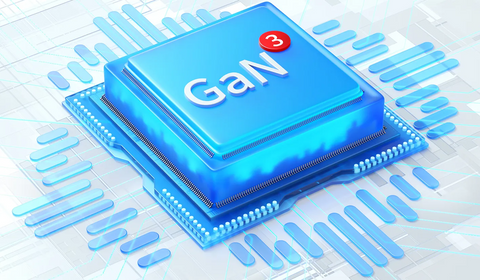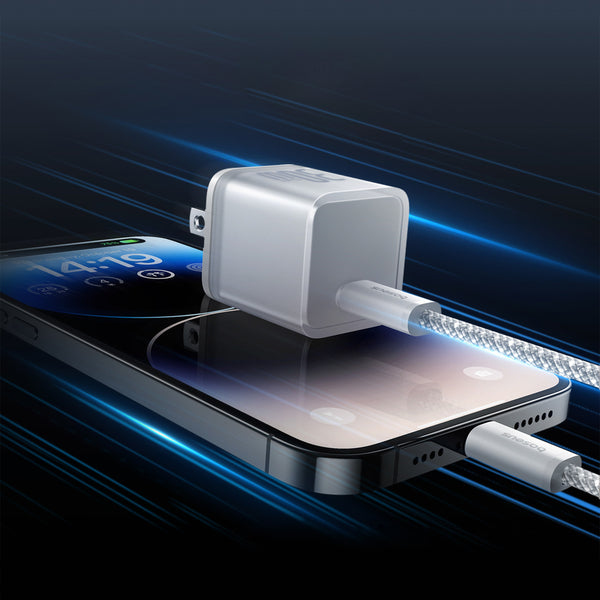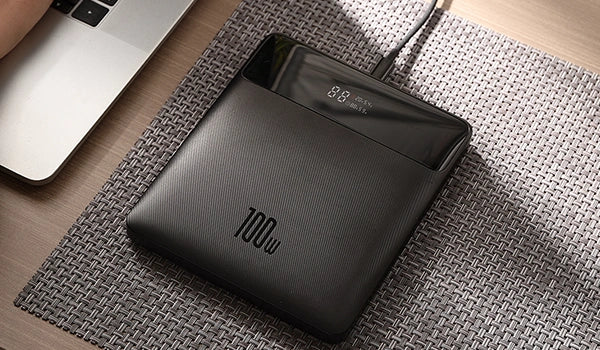GaN technology is gaining popularity in the use of chargers. Smartphones, tablets, laptops, and other commonly used smart devices have batteries. As a battery works by transferring power to devices, a chemical reaction takes place. A charger uses an electrical current to reverse that chemical reaction, adding power back to the battery and powering our devices. The world runs on battery-powered devices, placing a high demand on the best charging technology. This is where GaN comes in, offering the best, safest, fastest charging options.
GaN Technology

What is GaN technology? GaN technology uses gallium nitride, a hard, wide bandgap semiconductor. It is mechanically stable and has a higher breakdown strength, rapid switching speed, high thermal conductivity, and lower on-resistance. A material used to make LEDs and also popular for solar cell arrays in satellites. One significant aspect of GaN is that it produces less heat than other semiconductor materials. In addition, GaN costs less to manufacture and has the capability to conduct electrons more efficiently than silicon.
Gallium Nitride: Development
Gallium nitride is a synthetic element, produced through the smelting of bauxite ore to obtain aluminum and processing sphalerite ore for zinc. The production process has a relatively low carbon footprint and is accessible at an affordable cost, as it is a by-product of the aluminum and zinc refining process. The discovery of single crystal films of gallium nitride in the 1960s marked a milestone in the history of the element, with its high melting point of over 1600°C, 200°C higher than silicon.
In the 1970s, LEDs using GaN were created, and by the 1990s, high-brightness blue LEDs became commercially available and widely used by consumers. Today, GaN-based LED lights in red, green, and blue colors provide the primary lighting for LED-based displays such as LED-backlit LCD TVs and OLED displays. GaN technology has revolutionized the display industry, enabling high-resolution color screens for various devices including TVs, smartphones, tablets, laptops, and monitors.
The first demonstration of GaN transistors was in 1993, and by the 2000s, GaN transistors hit the market with the introduction of the first GaN high electron mobility transistor (HEMT). In 2014, GaN transistors became increasingly popular and widely used, offering improved performance and efficiency compared to traditional transistors.
GaN vs. Silicon
GaN outperforms silicon as a power semiconductor, and the capabilities of GaN are increasing. Silicon, though, is at its physical limit. Another advantage of GaN vs. silicon is the integration of power devices with signal and digital devices. GaN technology implemented in power sources today reduces the cost and size of fast chargers for end-user devices like smartphones and tablets.
Another significant advantage of GaN vs. silicon involves bandgap. The bandgap of Gan is almost triple that of silicon, allowing larger breakdown voltages and more thermal stability at high temperatures. In addition, the breakdown field of silicon is 0.3 MV/cm vs. 3.3 MV/cm for GaN making GaN more capable of supporting high-voltage designs. GaN also has superior electron mobility allowing for higher switching frequencies. There are many distinct advantages supporting using GaN over silicon for semiconductor applications.
Benefits of GaN Technology
Lighter Tech

It isn't the small structure of devices that makes them lightweight. Many small tech devices are heavy due to the amount of technology packed into a small frame. Gadgets made with GaN are small and light because GaN transistors have a high switching frequency allowing the use of smaller inductors and capacitors in the circuit, reducing the weight and volume of the device.
Reduced Costs
GaN transistors typically cost more than other transistors; however, using GaN transistors results in lower overall system costs. Therefore, implementing GaN technology allows manufacturers to reduce the size and costs of the components used in the device.
Energy Efficiency
Increased efficiency and capability with GaN technology reduce the energy and operating costs for devices such as chargers, LEDs, and other technology. Maximized energy efficiency is possible because GaN semiconductors sustain much higher temperatures, reducing energy consumption and improving device efficiency.
Faster Speeds
Gan technology speeds up processing power by using smaller working parts, higher switching frequencies, increased power density, and increased energy efficiency.
Increased Durability
GaN technology is mechanically stable and has a higher breakdown strength, which results in increased durability of devices using GaN. Devices made with GaN are less likely to fail, and they can withstand more demanding operating conditions.
Higher Power Density
GaN technology has a high thermal conductivity and low on-resistance, which results in higher power density. This means that more power can be delivered in a smaller package, making GaN-based devices more compact and efficient.
Wider Applications
GaN technology is versatile and can be used in a wide range of applications, including LED lighting, power supplies, rapid chargers, and automotive applications. This versatility makes GaN an attractive option for manufacturers looking to improve the performance and efficiency of their products.
Gallium Nitride Applications
Gallium nitride (GaN) technology has a wide range of applications and is rapidly growing in popularity due to its excellent performance and efficiency. Three of the most significant applications of GaN technology include LED lighting, power electronics, and radio frequency (RF) devices. Consumers are already well-aware of LED lighting and are now being introduced to other consumer-oriented applications of GaN technology. These include power supplies, rapid chargers, and some automotive applications. The widespread adoption of the Internet of Things (IoT) has further increased the demand for GaN technology in consumer electronics, with popular IoT items such as power banks, power strips, and chargers making use of this innovative technology.
In the power electronics industry, GaN technology is being used to develop smaller and more energy-efficient equipment with rapid charging capabilities. This is possible due to the high electron mobility of GaN, which enables faster switching and reduced power losses, resulting in higher power density, lower heat generation, and improved thermal management. GaN technology has been successfully integrated into power conversion systems, including DC-DC converters, AC-DC power supplies, and on-board chargers, among others.
GaN technology is also being used in the development of high-frequency RF devices, including amplifiers, oscillators, and switches, in a wide range of applications including telecommunications, defense, and aerospace. GaN devices offer improved performance, reduced size and weight, and reduced costs compared to traditional technologies, making them an attractive solution for many RF applications.
Are GaN Chargers Safe?
Before addressing safety questions it is important to understand, what is a GaN charger? A GaN charger is a gallium nitride charger. It is simply a charger, or commonly, a device used to recharge a battery powered end-user device such as a smartphone, tablet or laptop that uses Gallium nitride instead of silicon in its construction.
Is a GaN charger safe? Yes. Chargers that do not use GaN technology typically get hot while in use, which can be a fire hazard and damaging to your device. GaN chargers stay cool even when they are in use and charging devices at rapid speeds. In addition, they include safety features that intuitively adjust charging power to prevent overcharging.
Future Developments in GaN Technology

The future of GaN technology is bright, as it continues to offer significant advantages over other charging technologies. In the near future, we can expect to see more widespread use of GaN in various applications, including power supplies, rapid chargers, and automotive applications.
There is also potential for GaN to revolutionize the charging industry and provide more sustainable and efficient solutions for powering our devices. Additionally, researchers are working on developing new GaN-based materials with improved properties and applications, which will further enhance the capabilities of GaN technology.
With its high thermal stability, high breakdown voltages, high electron mobility, and low energy consumption, GaN technology has the potential to play a significant role in shaping the future of the charging industry.
GaN Chargers
There are several key factors to consider when shopping for a power-packed GaN charger. First, if you are looking for a GaN fast charger, consider the power rating. 10-watt - 65-watt chargers are considered fast charging devices. Another important detail to consider is the USB type and the number of ports for multiple device charging. Finally, ensuring your device is compatible with the charger you are considering, and UL (Underwriter Laboratories) or other safety certifications is critical.
Best GaN Chargers

- PowerMega 3 Ports Fast Charger 140W: This charger offers 60% more time saving using a shared charging system capable of charging four devices simultaneously. It can fast charge all USB-C laptops at maximum supported speeds. It utilizes GaNII technology offering a 30% smaller charging device that works five times faster yet operates at lower temperatures.

- Baseus GaN5 USB-C Fast Charger 30W: Smallest GaN charger offers USB-C fast charging capabilities and higher power conversion. Low-heat, safe charging protection. Compatible with iPhone 15!

- Baseus GaN3 Pro 4 Ports Desktop Charger 100W: New USB-C charger, slim desktop charger design. Charge phone, tablet, and USB-C laptop with one charger. Fast charging for up to four devices simultaneously.

- Baseus GaN 2-in-1 Power Bank 45W 10000mAh: Two-in-one portable charger with built-in AC plug. High-capacity portable battery featuring dual-port wall charger. Charge compatible USB-C devices with this power bank are great for all-day trips.



